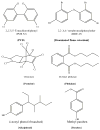Endocrine disrupting chemicals in indoor and outdoor air
- PMID: 20047015
- PMCID: PMC2677823
- DOI: 10.1016/j.atmosenv.2008.09.025
Endocrine disrupting chemicals in indoor and outdoor air
Abstract
The past 50 years have seen rapid development of new building materials, furnishings, and consumer products and a corresponding explosion in new chemicals in the built environment. While exposure levels are largely undocumented, they are likely to have increased as a wider variety of chemicals came into use, people began spending more time indoors, and air exchange rates decreased to improve energy efficiency. As a result of weak regulatory requirements for chemical safety testing, only limited toxicity data are available for these chemicals. Over the past 15 years, some chemical classes commonly used in building materials, furnishings, and consumer products have been shown to be endocrine disrupting chemicals-that is they interfere with the action of endogenous hormones. These include PCBs, used in electrical equipment, caulking, paints and surface coatings; chlorinated and brominated flame retardants, used in electronics, furniture, and textiles; pesticides, used to control insects, weeds, and other pests in agriculture, lawn maintenance, and the built environment; phthalates, used in vinyl, plastics, fragrances, and other products; alkylphenols, used in detergents, pesticide formulations, and polystyrene plastics; and parabens, used to preserve products like lotions and sunscreens. This paper summarizes reported indoor and outdoor air concentrations, chemical use and sources, and toxicity data for each of these chemical classes. While industrial and transportation-related pollutants have been shown to migrate indoors from outdoor sources, it is expected that indoor sources predominate for these consumer product chemicals; and some studies have identified indoor sources as the predominant factor influencing outdoor ambient air concentrations in densely populated areas. Mechanisms of action, adverse effects, and dose-response relationships for many of these chemicals are poorly understood and no systematic screening of common chemicals for endocrine disrupting effects is currently underway, so questions remain as to the health impacts of these exposures.
Figures






References
-
- Agency for Toxic Substances and Disease Registry. Toxicological Profile for Polychlorinated Biphenyls (PCBs) Atlanta: US Department of Health and Human Services; 2000. - PubMed
-
- Allen JG, McClean MD, et al. Personal exposure to polybrominated diphenyl ethers (PBDEs) in residential indoor air. Environmental Science & Technology. 2007;41(13):4574–9. - PubMed
-
- Arbeitsgemeinschaft PVC und Umwelt e.V. Plasticizers market data. 2006. from http://www.agpu.de.
Grants and funding
LinkOut - more resources
Full Text Sources
Other Literature Sources
Research Materials
Miscellaneous
